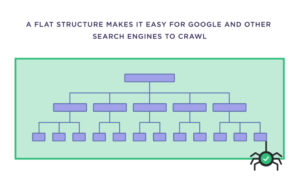Want to Improve Your Website's Google & ChatGPT Visibility?
Get specific suggestions to improve your SEO & GEO in about 45 seconds.
What is Technical SEO?
Technical Search Engine Optimization (Technical SEO) encompasses the optimization of a website's technical aspects, such as its architecture and backend infrastructure, with the goal of improving its visibility and performance in search engine results. In essence, it involves making the website more "search engine-friendly." Consequently, this often requires a collaborative effort between technical SEO specialists and web developers, particularly when dealing with large and complex websites.
Furthermore, Technical SEO involves a meticulous examination of various factors, including page load speed, site architecture, security measures, and the internal linking structure. For instance, the focus lies on identifying and eliminating any obstacles that might hinder search engine bots from effectively crawling, indexing, and rendering the website's content. Therefore, by addressing these technical issues, websites can significantly enhance their search engine rankings and ultimately attract more organic traffic.
CONTENTS
A complete guide to Technical SEO.
Technical SEO Fundamentals
Why Is Technical SEO Important?
You can have the best site with the best content.
But if your technical SEO is messed up?
Then you’re not going to rank.
At the most basic level, Google and other search engines need to be able to find, crawl, render and index the pages on your website.

But that’s just scratching the surface. Even if Google DOES index all of your site’s content, that doesn’t mean your job is done.
That’s because, for your site to be fully optimized for technical SEO, your site’s pages need to be secure, mobile optimized, free of duplicate content, fast-loading, meet Core Web Vitals requirements… and a thousand other things that go into technical optimization.
That’s not to say that your technical SEO has to be perfect to rank. It doesn’t.
But the easier you make it for Google to access your content, the better chance you have to rank.
Site Structure and Navigation

A well-designed site structure is the foundation of any technical SEO campaign. It can prevent crawling and indexing issues, and make other SEO tasks such as URL structure and robots.txt configuration easier. In general, a flat site structure is preferred, where all pages are only a few clicks away from each other. This makes it easier for search engines to crawl all of your pages. A well-organized site structure also helps avoid orphan pages and makes it easier to identify and fix indexing issues. Tools like Semrush Site Audit and Octopus.do can help you visualize your site structure.
Your URLs should also follow a consistent, logical structure that reflects the hierarchy of your website. This helps users understand where they are on your site and gives Google extra context about each page. For example, all pages on the SEO Marketing Hub website include the /hub/seo subfolder in their URLs.
Breadcrumbs navigation is also SEO-friendly because it automatically adds internal links to category and subpages on your site. This helps solidify your site architecture and is consistent with how Google displays URLs in the search results.
In conclusion, a strong site structure is essential for technical SEO and can make all other SEO tasks much easier.
Crawling, Rendering and Indexing
Search engine optimization (SEO) relies heavily on how search engines understand and process your website. This involves three crucial steps: crawling, rendering, and indexing. Crawling is the process where search engine bots (like Googlebot) discover and explore your website's pages by following links. Rendering involves how search engines interpret and display your web pages, including JavaScript and CSS. Finally, indexing is the process where search engines store and organize information from your rendered pages in their database.
Effective crawling, rendering, and indexing are essential for search engine visibility. If search engines can't crawl your pages, they won't be indexed and won't appear in search results. Similarly, if your pages render incorrectly, search engines may not understand their content, leading to lower rankings. By optimizing for these three steps, you ensure that search engines can understand and index your website correctly, improving your chances of ranking higher in search results.
Content Quality and Originality
While unique content is crucial for SEO, duplicate content can still occur, such as when your CMS creates multiple versions of a page. Thin content, though less of a concern for most sites, can still negatively impact rankings. To identify and address these issues:
- Utilize SEO Audit Tools: Tools like Raven Tools and Semrush can effectively pinpoint duplicate and thin content on your website.
- Check for External Duplicates: Use Copyscape's Batch Search to detect instances where your content appears on other websites.
- Implement "noindex" Tags: Prevent search engines from indexing pages with duplicate content by adding the "noindex" tag to their code. Verify the tag's effectiveness using Google Search Console's "Inspect URL" tool.
- Employ Canonical URLs: For pages with minor variations in content, use the canonical tag to designate the primary version of the page to Google.
By proactively addressing duplicate and thin content issues, you can improve your website's search engine rankings and ensure that search engines present the most relevant and valuable versions of your content to users.
Website Pages Loading Time
Boost Your SEO with Faster Loading Speeds
While backlinks are crucial for top rankings, optimizing your website's loading speed can significantly improve organic traffic. Here are 3 effective strategies:
-
Focus on Reducing Web Page Size: Studies show that a page's total size is a major factor impacting load times. Compressing images and caching can help, but excessively large pages will still load slowly. Consider the trade-off between image quality and loading speed for your website's content.
-
Test CDN Impact: Surprisingly, our research suggests that improperly configured CDNs can slow down websites. If you use a CDN, test your site speed with and without it using webpagetest.org to identify any potential issues.
-
Minimize Third-Party Scripts: Each third-party script on a page adds to its loading time. While essential scripts like Google Analytics should stay, audit your website's scripts regularly to remove unnecessary ones that slow down your site.
By implementing these strategies, you can ensure your website loads quickly, enhancing user experience and potentially improving your SEO rankings.
Technical SEO Tips
Essential Quick Wins for Your Technical SEO
This chapter covers several quick technical SEO tips to enhance your website's search engine visibility.
-
Utilize Hreflang Tags: For international websites with different language versions, implement hreflang tags to guide search engines to the most relevant content for each user. Use tools like Aleyda Solis' Hreflang Generator for easier implementation.
-
Address Broken Links: Regularly audit your website to identify and fix broken internal links, which can hinder search engine crawlability. Tools like Semrush and Screaming Frog can help you find and resolve these issues.
-
Implement Structured Data (Schema): While not a direct ranking factor, Schema can enhance your search results with Rich Snippets, potentially boosting your click-through rate.
-
Validate XML Sitemaps: Ensure your sitemap only includes live pages by validating it using tools like Map Broker XML Sitemap Validator.
-
Noindex Category and Tag Pages: If these pages don't contribute significantly to traffic, consider noindexing them to avoid duplicate content issues.
-
Prioritize Mobile Usability: With Google's mobile-first indexing, ensure your website is fully mobile-friendly. Use tools like Lighthouse to identify and fix mobile usability issues such as small text, unresponsive buttons, and content overflow.
By implementing these quick tips, you can significantly improve your website's technical SEO and enhance your overall search engine performance.
Who is SEO Fix it?
Aaron Jay
SEO Fix It was founded by Aaron Jay, who is a highly skilled website developer and marketing expert with over 25 years of experience, multiple certifications, patents and published apps. He loves helping people grow their business using the most current tools and advanced technology. His passion is helping businesses get to the next level.
Aaron Jay is often hired by other marketing companies to do the high-level technie stuff, that their normal team isn't able to handle in-house.
Many of the current SEO Fix It clients tried to use cheaper offshore agencies first, but when their project became over due and over budget, hired us and have never been happier.

Aaron Jay with his Schnauzers!
Work with SEO Fix It
Unlike typical marketing companies, this is not a contact form to get bombarded with high-pressure sales pitches. With our 0% Risk Reversal Guarantee, WE are taking the risk by working with you first, and trusting that you will pay us when you see improvements. We will prioritize businesses that we feel would have the greatest chance of success, understand the value of SEO and are doing good things in the world.
We also reserve the right not to work with businesses we feel to be hateful, directly compete with existing clients, or feel are not serious about growing their business.
While not every business will qualify to work with us, we will give you feedback on your application within one business day.

Floor 13 - Suite 1300-9
Orlando , FL 32801
| Monday | 09:00 AM - 05:00 PM |
| Tuesday | 09:00 AM - 05:00 PM |
| Wednesday | 09:00 AM - 05:00 PM |
| Thursday | 09:00 AM - 05:00 PM |
| Friday | 09:00 AM - 02:00 PM |
| Saturday | closed |
| Sunday | closed |
